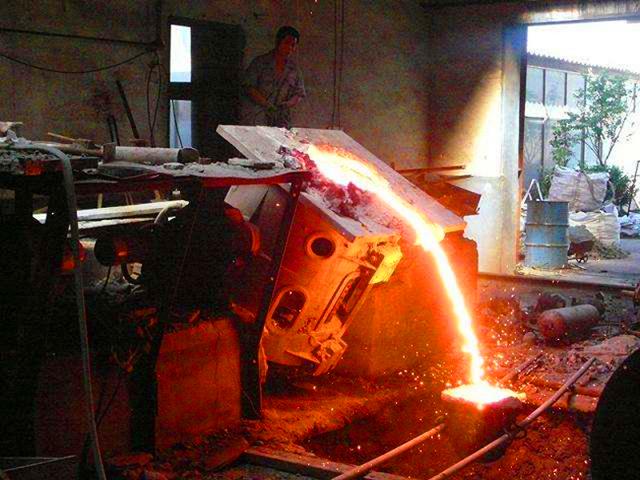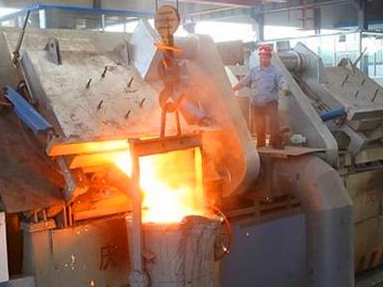Application and Precautions of Electric Furnaces in Gray and Ductile Iron Casting
2025-01-09 10:42:43 hits:0
1. Application of Electric Furnaces in the Casting of Gray Iron
Gray iron is the most common type of cast iron, widely used in casting components like engine blocks, machine beds, pipes, and valves. Electric furnaces are commonly used for melting gray iron, especially in medium-frequency induction furnaces and electric arc furnaces.
(1) Melting Process of Gray Iron
When using electric furnaces to melt gray iron, temperature control is crucial. The melting process includes the following steps:
Charging of Furnace Materials: Charge iron ore, scrap iron, and alloying elements (such as silicon, manganese, chromium, copper, etc.) into the furnace. To maintain low carbon content in gray iron, scrap steel or iron chips are usually mixed with alloy metals.
Heating and Melting: The electric arc furnace or medium-frequency induction furnace heats the materials to melt them. Temperature control is very important during the melting process. Too high a temperature can increase carbon content excessively, while too low a temperature can result in weak castings.
Adding Alloying Elements: During the melting process, alloying elements, such as silicon, manganese, and nickel, are added to improve wear resistance, corrosion resistance, and other properties.
Control of Furnace Slag: Slag generated during melting needs to be regularly removed. Furnace slag contains impurities that can affect the purity of the molten metal and the alloy composition.
(2) Advantages of Electric Furnace Melting for Gray Iron
Precise Temperature Control: Electric furnaces provide accurate temperature control, ensuring the melting process stays within ideal ranges, avoiding overheating or cooling issues.
Control of Alloy Composition: Electric furnaces allow precise control over the composition of gray iron, ensuring it meets the required mechanical properties.
Increased Melting Efficiency: Medium-frequency induction furnaces provide rapid heating, reducing heat loss and improving production efficiency.
(3) Precautions
Temperature Control: The melting temperature of gray iron is generally between 1400°C and 1450°C. Too high a temperature may cause excess carbon, negatively impacting the quality and performance of castings. Accurate control of furnace power and time is necessary.
Selection and Preparation of Furnace Materials: Furnace materials should be clean and free of impurities. The selection of scrap steel and alloy elements should ensure the proper chemical composition, preventing any impact on the melting process.
Oxidation and Alloy Loss: During high-temperature melting, molten metal may react with oxygen to form iron oxides, leading to material loss and waste. Therefore, controlling the furnace atmosphere is essential.
Cleaning Furnace Slag: Furnace slag should be cleaned in a timely manner to prevent it from contaminating the molten metal and impacting the quality of castings.
2. Application of Electric Furnaces in the Casting of Ductile Iron
Ductile iron (also known as nodular cast iron) is a type of cast iron where graphite exists in a spherical shape, offering excellent strength, toughness, and wear resistance. Ductile iron is widely used in components like automobile engine parts, wheels, and machine parts.
(1) Melting Process of Ductile Iron
Electric furnaces play a key role in the melting of ductile iron, especially in medium-frequency induction furnaces and electric arc furnaces. The melting process includes the following steps:
Preparation of Furnace Materials: Similar to gray iron, the melting of ductile iron requires the use of scrap steel, alloying elements, and magnesium alloys. Magnesium is a key element for promoting the transformation of graphite from flake to spherical form.
Melting and Heating: Furnace materials are placed in an electric furnace, and the electric arc furnace or medium-frequency induction furnace heats them to about 1500°C to 1600°C. Temperature control is especially critical during the addition of magnesium.
Adding Magnesium Alloy: Magnesium alloys are added during the melting process to promote the transformation of graphite from flake to spherical. The timing and amount of magnesium added must be strictly controlled. After the addition of magnesium, the temperature is maintained within a specified range to ensure full reaction of the magnesium with the molten iron.
Temperature and Composition Adjustment: Furnace temperature and composition are adjusted to ensure that magnesium alloys dissolve completely, and the carbon content stays within the desired range. Other alloying elements, such as silicon, manganese, and aluminum, may also be added to meet performance requirements.
Pouring into Molds: The molten ductile iron is then poured into molds for casting.
(2) Advantages of Electric Furnace Melting for Ductile Iron
Control of Graphite Shape: Electric furnaces allow precise control of the melting temperature and timing of magnesium addition, ensuring that the graphite in the iron forms into spherical shapes, which significantly enhances mechanical properties.
Precise Control of Alloy Composition: Electric furnaces provide accurate control over the chemical composition of ductile iron, particularly for elements like carbon, silicon, and magnesium, ensuring stable product quality.
Increased Production Efficiency: Compared to traditional blast furnaces, electric furnace melting is faster and more efficient, reducing energy consumption and lowering production costs.
(3) Precautions
Control of Magnesium Addition: The amount, timing, and method of adding magnesium are critical. Too much or too little magnesium can result in improper graphite formation, compromising the strength and toughness of the castings. Magnesium addition must be precisely controlled and calculated.
Temperature Control: The melting temperature for ductile iron generally ranges between 1500°C and 1600°C. If the temperature is too high or too low, it could affect the alloy distribution and casting quality.
Control of Furnace Atmosphere: To prevent oxidation and decarburization, the atmosphere inside the electric furnace must be strictly controlled to avoid oxidation of the molten iron and low carbon content.
Selection and Treatment of Furnace Materials: Ensure that the furnace materials are of high quality, especially the scrap steel and alloy elements, which should be free of impurities to avoid impacting the quality of ductile iron.
Timely Cleaning of Furnace Slag: Furnace slag should be cleaned regularly during the melting process to prevent it from affecting the temperature and quality of the molten metal.

 en
en  fra
fra  de
de  ru
ru  gle
gle  th
th  ara
ara  it
it  jp
jp  kor
kor  zh
zh 




